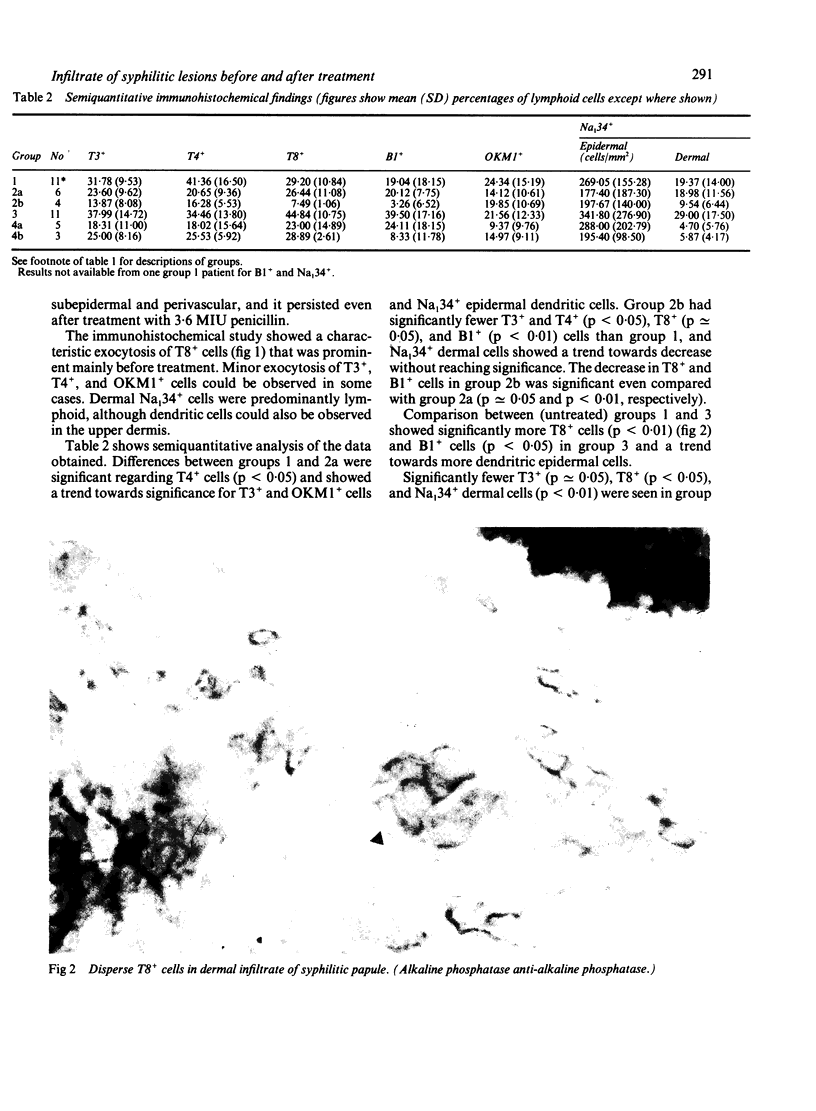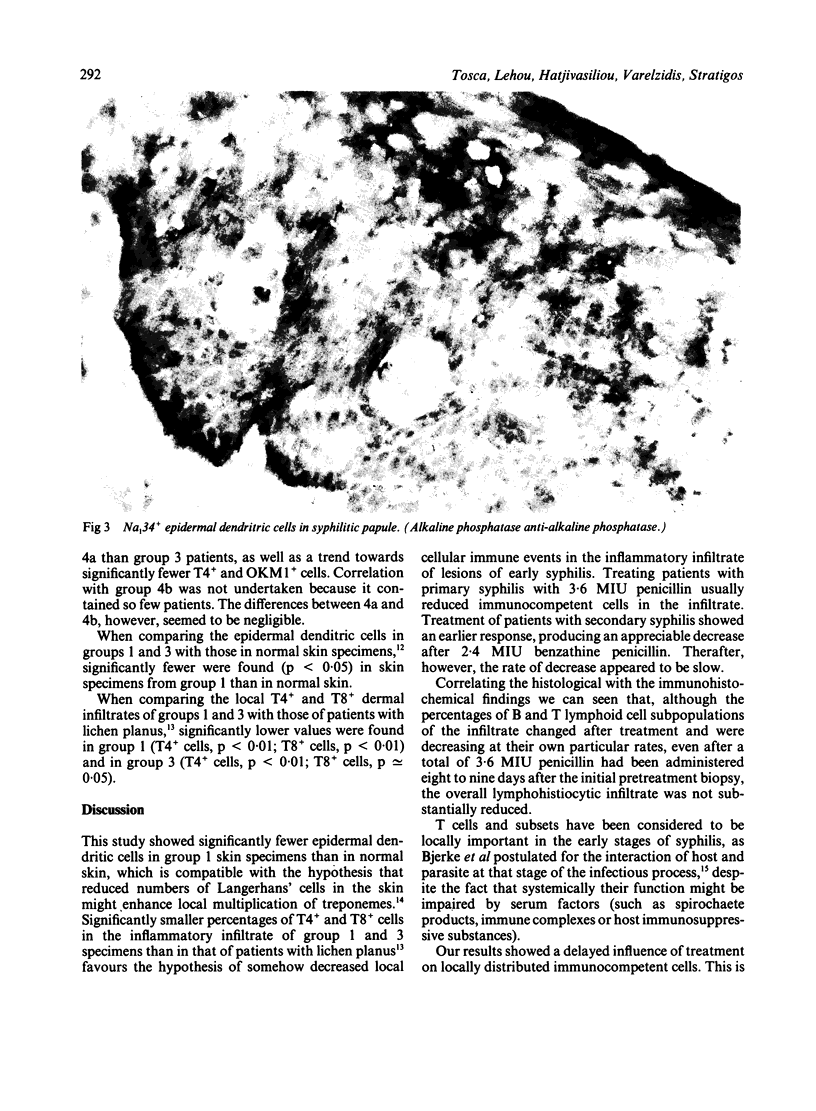Abstract
An immunohistological study of skin biopsy specimens from patients with early syphilis was undertaken before and after treatment (one day after intramuscular administration of 2.4 MIU benzathine penicillin and eight days later, after a total administration of 3.6 MIU. In chancres from seronegative patients treatment with 3.6 MIU usually resulted in fewer immunocompetent cells in the infiltrate. In lesions of secondary syphilis treatment with 2.4 MIU benzathine penicillin produced a significant decrease in immunocompetent cells. After treatment with 3.6 MIU there was no further decrease. It was worth noticing that even eight to nine days after the initial pretreatment biopsy, when 3.6 MIU had been administered, the overall lymphohistiocytic infiltrate was not substantially diminished. Significantly more suppressor (T8+) cells were found in lesions of primary syphilis than of secondary syphilis, and they showed remarkable exocytosis. Activated local T8+ cells may release immunosuppressive lymphokines.
Full text
PDF




Images in this article
Selected References
These references are in PubMed. This may not be the complete list of references from this article.
- Bjerke J. R., Krogh H. K., Matre R. In situ identification of mononuclear cells in cutaneous infiltrates in discoid lupus erythematosus, sarcoidosis and secondary syphilis. Acta Derm Venereol. 1981;61(5):371–380. [PubMed] [Google Scholar]
- Bădănoi A., Gavrilesco M., Nicolau G., Cîrciumaresco T. Lymphoblastogenèse immunoallergique et antigène tréponémique in vitro dans la syphilis. Arch Roum Pathol Exp Microbiol. 1969 Jun-Sep;28(2):419–427. [PubMed] [Google Scholar]
- From E., Thestrup-Pedersen K., Thulin H. Reactivity of lymphocytes from patients with syphilis towards T. pallidum antigen in the leucocyte migration and lymphocyte transformation tests. Br J Vener Dis. 1976 Aug;52(4):224–229. doi: 10.1136/sti.52.4.224. [DOI] [PMC free article] [PubMed] [Google Scholar]
- Fulford K. W., Brostoff J. Leucocyte migration and cell-mediated immunity in syphilis. Br J Vener Dis. 1972 Dec;48(6):483–488. doi: 10.1136/sti.48.6.483. [DOI] [PMC free article] [PubMed] [Google Scholar]
- Gschnait F., Schoenwald E., Schmidt B. L., Luger A. Laboratory evidence for impaired cellular immunity in different stages of syphilis. J Invest Dermatol. 1982 Jul;79(1):40–41. doi: 10.1111/1523-1747.ep12510575. [DOI] [PubMed] [Google Scholar]
- Janot C., Grandidier M., Pupil P., Thomas J. L., Beurey J., de Lavergne E. Le test de transformation lymphoblastique au cours de la syphilis. Presse Med. 1971 Oct 16;79(43):1901–1904. [PubMed] [Google Scholar]
- Jensen J. R., From E. Alterations in T lymphocytes and T-lymphocyte subpopulations in patients with syphilis. Br J Vener Dis. 1982 Feb;58(1):18–22. doi: 10.1136/sti.58.1.18. [DOI] [PMC free article] [PubMed] [Google Scholar]
- McMillan E. M., Wasik R., Beeman K., Everett M. A. In situ immunologic phenotyping of mycosis fungoides. J Am Acad Dermatol. 1982 May;6(5):888–897. doi: 10.1016/s0190-9622(82)70078-7. [DOI] [PubMed] [Google Scholar]
- Mittag H., Klingmüller G. Langerhans cells in granulomatous syphilis. Arch Dermatol Res. 1983;275(3):190–196. doi: 10.1007/BF00510051. [DOI] [PubMed] [Google Scholar]
- Moretta A., Mingari M. C., Santoli D., Perlmann P., Moretta L. Human T-lymphocyte subpopulations: alterations in systemic lupus erythematosus. Scand J Immunol. 1979;10(3):223–228. doi: 10.1111/j.1365-3083.1979.tb01343.x. [DOI] [PubMed] [Google Scholar]
- Pavis C. S., Folds J. D., Baseman J. B. Cell-mediated immunity during syphilis. Br J Vener Dis. 1978 Jun;54(3):144–150. doi: 10.1136/sti.54.3.144. [DOI] [PMC free article] [PubMed] [Google Scholar]
- Schaumburg-Lever G. Immunoenzyme techniques in dermatopathology. Int J Dermatol. 1986 May;25(4):217–223. doi: 10.1111/j.1365-4362.1986.tb02228.x. [DOI] [PubMed] [Google Scholar]
- Schell R. F., Musher D. M. Detection of nonspecific resistance to Listeria monocytogenes in rabbits infected with Treponema pallidum. Infect Immun. 1974 Apr;9(4):658–662. doi: 10.1128/iai.9.4.658-662.1974. [DOI] [PMC free article] [PubMed] [Google Scholar]
- Tabor D. R., Azadegan A. A., Schell R. F., Lefrock J. L. Inhibition of macrophage C3b-mediated ingestion by syphilitic hamster T cell-enriched fractions. J Immunol. 1984 Nov;133(5):2698–2705. [PubMed] [Google Scholar]
- Tosca A. D., Varelzidis A. G., Economidou J., Stratigos J. D. Mycosis fungoides: evaluation of immunohistochemical criteria for the early diagnosis of the disease and differentiation between stages. J Am Acad Dermatol. 1986 Aug;15(2 Pt 1):237–245. doi: 10.1016/s0190-9622(86)70163-1. [DOI] [PubMed] [Google Scholar]
- Wright D. J., Grimble A. S. Why is the infectious stage of syphilis prolonged? Br J Vener Dis. 1974 Feb;50(1):45–49. doi: 10.1136/sti.50.1.45. [DOI] [PMC free article] [PubMed] [Google Scholar]





